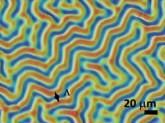Elastic Plasmonic-Enhanced Fabry–Pérot Cavities with Ultrasensitive Stretching Tunability
The emerging stretchable photonics field faces challenges, like the robust integration of optical elements into elastic matrices or the generation of large optomechanical effects. Here, the first stretchable plasmonic-enhanced and wrinkled Fabry–Pérot (FP) cavities are demonstrated, which are composed of self-embedded arrays of Au nanostructures at controlled depths into elastomer films. The novel self-embedding process is triggered by the Au nanostructures’ catalytic activity, which locally increases the polymer curing rate, thereby inducing a mechanical stress that simultaneously pulls the Au nanostructures into the polymer and forms a wrinkled skin layer. This geometry yields unprecedented optomechanical effects produced by the coupling of the broad plasmonic modes of the Au nanostructures and the FP modes, which are modulated by the wrinkled optical cavity. As a result, film stretching induces drastic changes in both the spectral position and intensity of the plasmonic-enhanced FP resonances due to the simultaneous cavity thickness reduction and cavity wrinkle flattening, thus increasing the cavity finesse. These optomechanical effects are exploited to demonstrate new strain-sensing approaches, achieving a strain detection limit of 0.006%, i.e., 16-fold lower than current optical strain-detection schemes.





